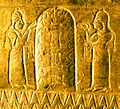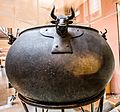Urartu facts for kids
Urartu (also called Biainili by its own people) was an ancient kingdom. It was located in a mountainous area, now known as the Armenian Highland. This region is found between Asia Minor (modern-day Turkey), Mesopotamia (modern-day Iraq), and the Caucasus Mountains. The heart of the kingdom was around Lake Van, which is in eastern Turkey today. Urartu existed for a long time, from about 860 BC until 585 BC. Its name is connected to the Biblical Ararat.
Urartu stretched from Lake Van towards the southeast, reaching a place called Mannai. Sometimes, Mannai was even a part of the Urartian kingdom.
Contents
About the Kingdom of Urartu
Urartu was a powerful kingdom in ancient times. It grew out of smaller groups of people known as Nairi polities during the late Bronze Age. The people of Urartu were skilled builders and artists. They created strong fortresses and beautiful metalwork.
Where Was Urartu Located?
The kingdom of Urartu was in a very mountainous region. This area is often called the Armenian Highland. It was a strategic location, sitting between several important ancient civilizations. To its west was Asia Minor, to its south was Mesopotamia, and to its north were the Caucasus Mountains. The large Lake Van was central to their lands.
When Did Urartu Exist?
The kingdom of Urartu began around 860 BC. This was a time when many new kingdoms were forming after the Bronze Age. Urartu lasted for nearly 300 years. It finally came to an end around 585 BC. During its time, Urartu was a major power in the Near East.
What Was Urartu Known For?
The Urartians were famous for their metalwork, especially bronze. They made helmets, shields, and cauldrons with detailed designs. Many of these items showed scenes of daily life, gods, or animals. They also built impressive cities and fortresses. These structures often had strong stone walls and complex water systems. The Urartian language was written using cuneiform, a type of writing with wedge-shaped marks.
Related pages
Images for kids
-
Fragment of a bronze helmet from Argishti I's era. The "tree of life", popular among the ancient societies, is depicted. The helmet was discovered during the excavations of the fortress Of Teyshebaini on Karmir-Blur (Red Hill).
-
Silver bucket from Urartu in the Museum zu Allerheiligen in Schaffhausen Switzerland, allegedly from the tomb of Prince Inuspua, 810 BC
-
Urartian cuneiform recording the foundation of Erebuni Fortress by Argishti.
See also
 In Spanish: Urartu para niños
In Spanish: Urartu para niños









